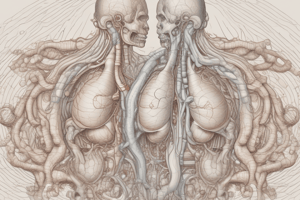Podcast
Questions and Answers
What is the result of gas exchange across the respiratory membrane?
What is the result of gas exchange across the respiratory membrane?
- Both O2 and CO2 are retained in the blood
- O2 diffuses into pulmonary capillaries and CO2 diffuses into the alveoli (correct)
- O2 diffuses into the alveoli
- CO2 diffuses into pulmonary capillaries
Which statement correctly describes the partial pressure of a gas in blood?
Which statement correctly describes the partial pressure of a gas in blood?
- It includes gases that are bound to hemoglobin.
- It is the total pressure of all gases present in the blood.
- It is solely determined by the gas's concentration.
- It reflects the amount of gas dissolved in solution, excluding bound forms. (correct)
What happens to the partial pressure of oxygen (PO2) after loading in the alveoli?
What happens to the partial pressure of oxygen (PO2) after loading in the alveoli?
- It equals the partial pressure of carbon dioxide in the blood.
- It remains constant at 100 mmHg. (correct)
- It increases to 160 mmHg.
- It decreases to 40 mmHg.
What contributes to the altered composition of alveolar air compared to inspired air?
What contributes to the altered composition of alveolar air compared to inspired air?
What is the typical partial pressure of carbon dioxide (PCO2) in mixed venous blood?
What is the typical partial pressure of carbon dioxide (PCO2) in mixed venous blood?
During the unloading of CO2, which of the following occurs?
During the unloading of CO2, which of the following occurs?
What is the partial pressure of oxygen (PaO2) in end alveolar capillary blood when gas exchange is normal?
What is the partial pressure of oxygen (PaO2) in end alveolar capillary blood when gas exchange is normal?
What is not a factor influencing the composition of alveolar air?
What is not a factor influencing the composition of alveolar air?
Flashcards are hidden until you start studying
Study Notes
Gas Exchange
- Gas exchange is the diffusion of gases across the respiratory membrane. This membrane separates the air in the alveoli from the blood in the pulmonary capillaries.
- The partial pressure of a gas is the pressure exerted by that gas in a mixture of gases. This is calculated as the total pressure of the mixture multiplied by the fractional concentration of the gas.
- The partial pressure of a gas in blood is produced by the dissolved gas that is free in the solution. This means that only dissolved gas molecules contribute to the partial pressure, not those bound to other molecules like hemoglobin.
Partial Pressures of Gases
- Dry inspired air contains 21% oxygen (PO2 =160 mmHg) and almost no carbon dioxide (PCO2=0 mmHg).
- Alveolar air differs from inspired air due to three factors: saturation with water vapor, loading of oxygen into the blood, and adding carbon dioxide from the blood. This results in a lower partial pressure of oxygen (PAO2) in the alveoli (100 mmHg) and a higher partial pressure of carbon dioxide (PACO2) (40 mmHg).
- Mixed venous blood (blood reaching the pulmonary capillaries) has a lower partial pressure of oxygen (PV O2 =40 mmHg) and a higher partial pressure of carbon dioxide (PV CO2 =45 mmHg).
Loading of Oxygen
- Oxygen diffuses along its partial pressure gradient from the alveolus into the blood until equilibrium is reached within the first third of the capillary. This means that oxygen moves from the alveoli, where its partial pressure is higher, into the blood, where the partial pressure is lower.
- Blood leaving the alveolar capillaries has been oxygenated and has a PO2 equal to PAO2 = 100 mmHg.
Unloading of Carbon Dioxide
- Carbon dioxide diffuses along its partial pressure gradient from the blood into the alveolus until equilibrium is reached. This means that carbon dioxide moves from the blood, where its partial pressure is higher, into the alveoli, where the partial pressure is lower.
- Blood leaving the pulmonary capillaries has a PCO2 equal to PACO2 = 40 mmHg.
Partial Pressures in End Alveolar Capillary Blood
- If gas exchange in the alveoli is normal, the partial pressure of gases in end capillary blood will be equal to the alveolar partial pressures. This means that the partial pressure of oxygen in end capillary blood (PaO2) will be equal to the partial pressure of oxygen in the alveoli (PAO2 = 100 mmHg), and the partial pressure of carbon dioxide in end capillary blood (PaCO2) will be equal to the partial pressure of carbon dioxide in the alveoli (PACO2 = 40 mmHg).
Studying That Suits You
Use AI to generate personalized quizzes and flashcards to suit your learning preferences.



